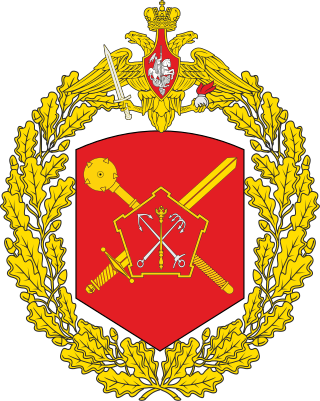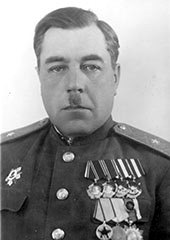The 4th Army was a Soviet field army of World War II that served on the Eastern front of World War II and in the Caucasus during the Cold War. It was disbanded after the fall of the Soviet Union, with its divisions being withdrawn to Russia and disbanded.

The 6th Red Banner Combined Arms Army is a field army of the Red Army and the Soviet Army that was active with the Russian Ground Forces until 1998 and has been active since 2010 as the 6th Combined Arms Army. Military Unit number в/ч 31807.
A rifle corps was a Soviet corps-level military formation during the mid-twentieth century. Rifle corps were made up of a varying number of rifle divisions, although the allocation of three rifle divisions to a rifle corps was common during the latter part of World War II.
The 14th Army was a field army of the Soviet Army, formed twice.

The 11th Guards Army was a field army of the Red Army, the Soviet Ground Forces, and the Russian Ground Forces, active from 1943 to 1997.
The 26th Army was a field army of the Soviet Union's Red Army, active from 1941.
The 19th Army was a field army of the Soviet Union's Red Army, formed in 1941 and active during the Second World War. The army was formed three times, although only two of its formations saw combat.
The 22nd Army was a field army of the Red Army during World War II.

Roman Ivanovich Panin was a Soviet major general from during World War II. An Imperial Russian Army junior officer in World War I, he joined the Red Army in 1919. Panin fought in the Russian Civil War and continued to serve after the end of the Russian Civil War. He was an advisor to the National Revolutionary Army between 1938 and 1939. Later he participated in the Soviet-Finnish war as a corps commander, and during World War II as the commander of the 14th Army, commanding the defense of Murmansk during Operation Silver Fox. Panin became commander of the 2nd Reserve Army in May 1942 and two months later became a lecturer at the Frunze Military Academy. In February 1943 he became Volkhov Front chief of combat training and in September led the 7th Rifle Corps. After participating in the Leningrad–Novgorod Offensive, Panin briefly led the 99th Rifle Corps. In July 1944, Panin became deputy commander of the 5th Army. Hospitalized in February 1945 during the East Prussian Offensive, Panin did not see further action. After recovering he became an instructor at the Frunze Military Academy and retired in 1949. He died shortly afterwards.

The 20th Army was a field army of the Red Army that fought on the Eastern Front during World War II.
The 46th Army was a Soviet Red Army field army during World War II. The army was formed in August 1941 and guarded the Turkish border. During the summer of 1942, it fought in the Battle of the Caucasus. During the spring of 1943, the army helped capture Maykop and Krasnodar. During the summer of 1943, it fought in the Donbass Strategic Offensive and the Battle of the Dnieper. During early 1944, it fought in the Nikopol–Krivoi Rog Offensive and the Odessa Offensive. During the summer it fought in the Second Jassy–Kishinev Offensive. The army advanced westward and participated in the Battle of Debrecen and Budapest Offensive during the fall. After the fall of Budapest in February 1945, the army fought in the Vienna Offensive and the Prague Offensive. During the summer of 1945, the army moved to the Odessa Military District and was disbanded in September.
The 42nd Army was a field army of the Soviet Union's Red Army, created in 1941.
The 48th Army was a field army of the Soviet Red Army, active from 1941 to 1945. The army was first formed in August 1941 and fought in the Leningrad Strategic Defensive Operation. The army suffered heavy losses and was disbanded in early September. Its remnants were moved to the 54th Army. Reformed in April 1942 on the Bryansk Front, the army fought in the Maloarkhangelsk Offensive in the winter of 1943. It was sent to the Central Front in March and defended the northern face of the Kursk Bulge. During the summer, it fought in Operation Kutuzov and the Chernigov-Pripyat Offensive. From November, the army fought in the Gomel-Rechitsa Offensive. The army fought in Operation Bagration from June 1944. During the offensive, the army captured Zhlobin and Bobruisk and was on the Narew by early September. During early 1945, the army fought in the East Prussian Offensive and ended the war in East Prussia during May. The army was transferred to Poland in July 1945 and its headquarters was used to form the Kazan Military District in September.
The 7th Rifle Corps was a corps in Red Army and Soviet Armed Forces, before and during The Great Patriotic War/World War II.
The 34th Guards Rifle Division was a rifle division of the Red Army during World War II.
The 53rd Army was a field army of the Soviet Union's Red Army which was formed in August 1941, disbanded in December 1941, and reformed in May 1942. It fought throughout World War II before again being disbanded after the war in October 1945. The army was first formed for the Anglo-Soviet invasion of Iran and was disbanded there in December 1941. The army reformed in May 1942. It fought in the Demyansk Pocket, the Battle of Kursk, the Battle of Belgorod, the Battle of the Dnieper, the Battle of the Korsun–Cherkassy Pocket, the Uman–Botoșani Offensive, the Second Jassy–Kishinev Offensive, the Battle of Debrecen, the Budapest Offensive, and the Prague Offensive. At the end of the war in Europe it was moved to the Far East and fought in the Soviet invasion of Manchuria. The army was disbanded in October 1945.
The 61st Rifle Corps was a Red Army infantry corps during World War II, formed twice. The 61st Rifle Corps was formed firmed in Tula during September 1939. After Operation Barbarossa, it was transferred to the front in Belarus and fought in the Battle of Smolensk. After suffering heavy losses at Smolensk, it was disbanded in early August 1941. Reformed in spring 1943, the corps fought in Operation Kutuzov, the Lublin–Brest Offensive and the Berlin Offensive. The corps was disbanded after the end of the war in summer 1945.
The 399th Rifle Division was an infantry division of the Red Army. Partially raised in 1941, this formation was abandoned until a second formation began in February 1942, this time in the far east of Siberia. The formation lasted until July, after which it was moved west to join the Stalingrad Front in the great bend of the Don River. Badly mauled in its first actions, it was rebuilt west of the Don in late July, and went on to contest the German advance right into the center of the city. The remnants of the division were pulled out and sent north to Bryansk Front, and the once-again rebuilt division went on to serve in the winter offensive against the German forces in the salient around Oryol. It was present on the right flank of the Kursk salient during the German offensive in July 1943 but saw little action until the Soviet forces went on the counterattack later that month. During the advance into western Russia it earned a battle honor. Through the winter of 1943-44 it helped to make incremental gains against the forces of Army Group Center, setting the stage for the summer offensive, during which the division would win its first decoration. Later that year it advanced into Poland and in early 1945 it took part in the battles for East Prussia, and won the Order of the Red Banner for its efforts. The division was disbanded shortly thereafter.
The 263rd Rifle Division was an infantry division of the Red Army during World War II.
The 12th Rifle Corps was an infantry corps of the Red Army during the interwar period and World War II, formed four times.



